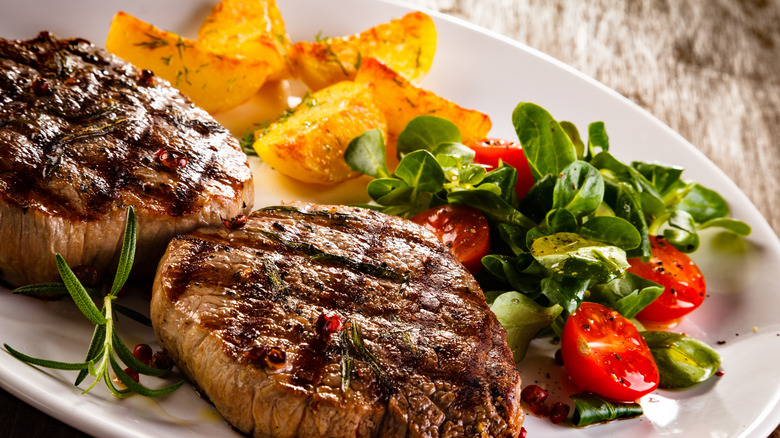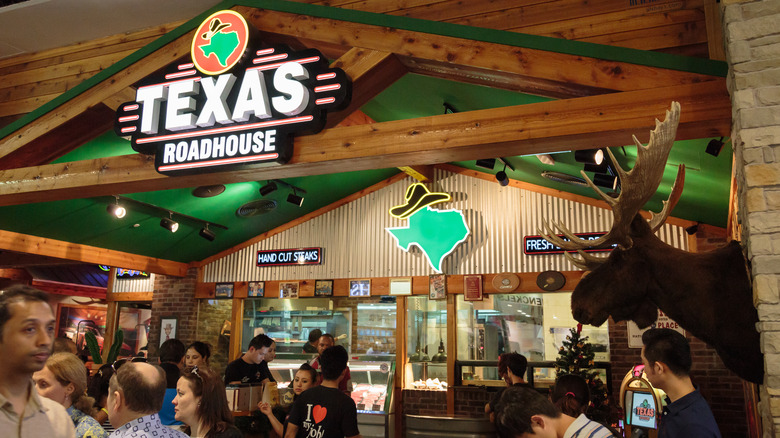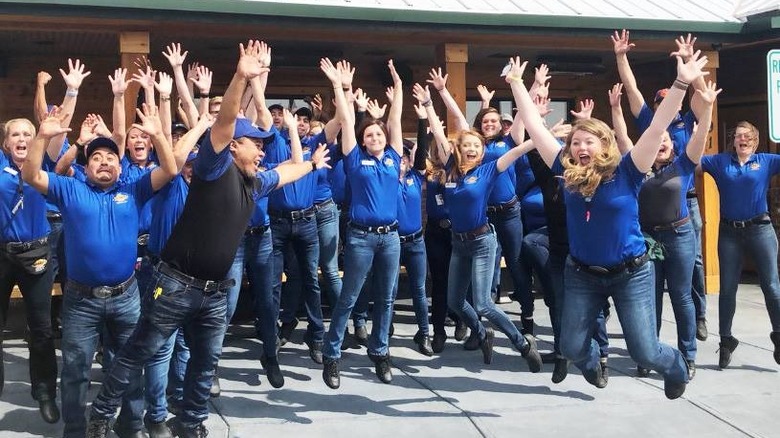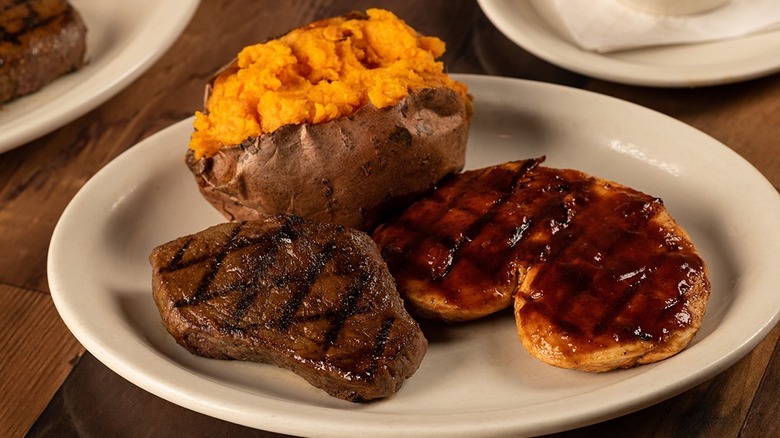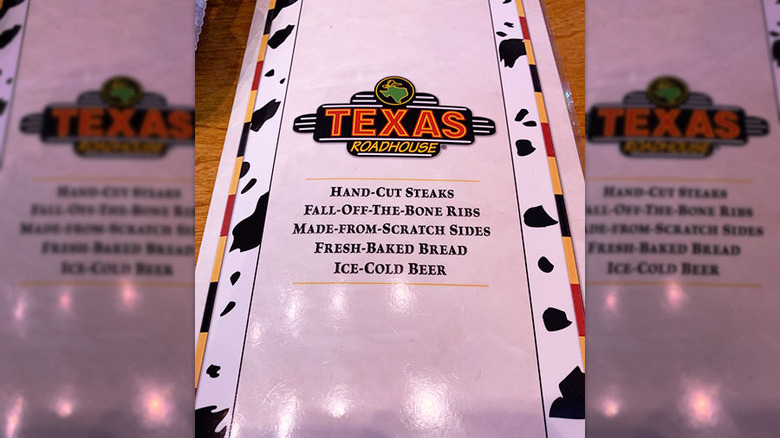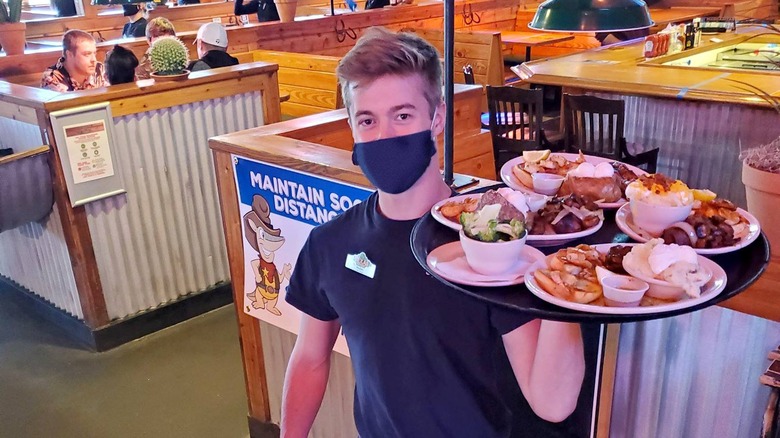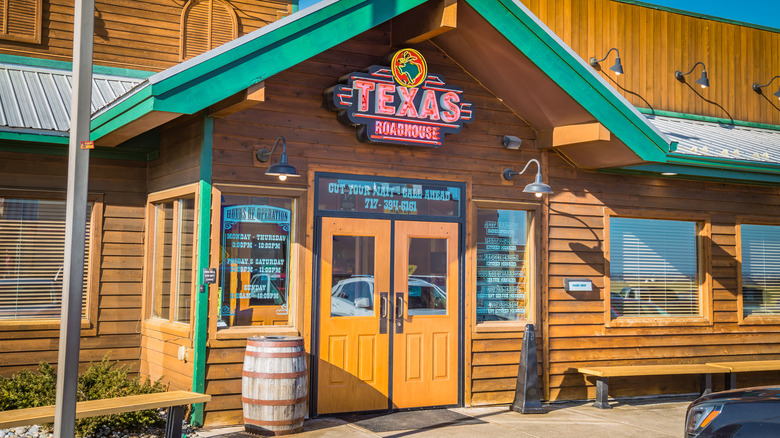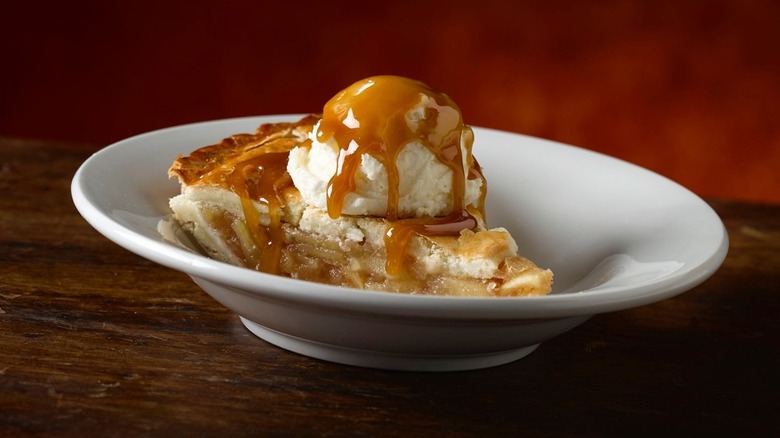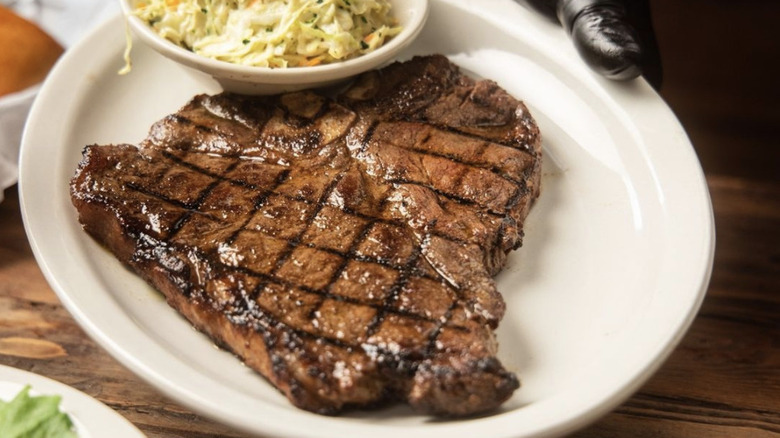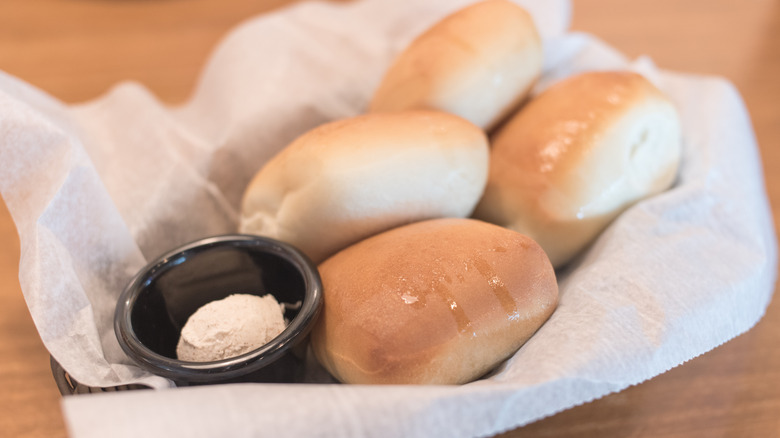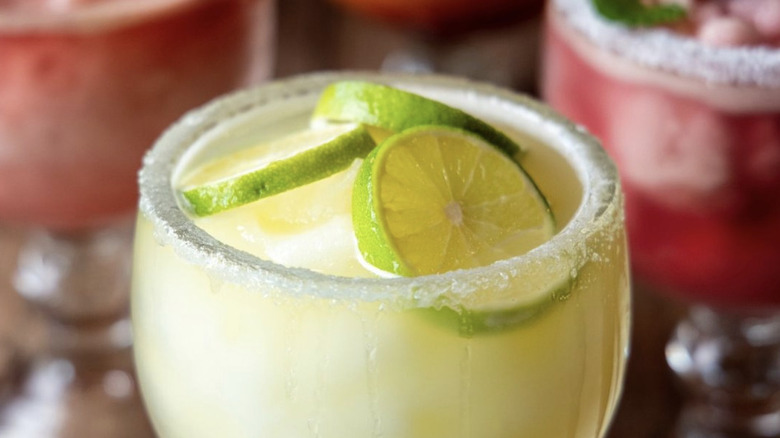We Finally Know Why Texas Roadhouse Is So Cheap
There's little doubt that Texas Roadhouse is a favorite with carnivores. The steakhouse has been dishing out hand-cut steaks, chicken specialties, and fall-off-the-bone ribs since the chain opened its first outlet in Indiana in 1993. Today, Texas Roadhouse is one of the largest steakhouse chains in the U.S., with over 580 locations in the country and internationally (via Texas Roadhouse). Noisy and busy, the dining spot attracts families and casual diners looking to dig into a tender and juicy cut of meat without the formality of dressing up.
With the slogan "Legendary Food, Legendary Service," Texas Roadhouse is all about delivering top-notch dishes at attractive price points. The franchises' CEO Kent Taylor summed up the company's ethos when he told Investor's Business Daily, "Our competitors are all chasing fads and losing focus. Our guests like to come in and see we still have value prices and great quality food." It's not always easy to get a steak dinner on the cheap, so how is Texas Roadhouse able to offer such affordable menu items? It's not by sheer luck, but a carefully laid out strategy that keeps customers coming back and yields strong profit margins. Keep reading to find out.
Texas Roadhouse draws a lot of traffic
To say that Texas Roadhouse is hugely popular is an understatement. With close to 600 locations across the world — each serving around 5,000 guests per week — Texas Roadhouse is a steakhouse powerhouse. In fact, the chain serves a whopping 300,000 meals per day, which is a lot even for a franchise. As such, it's little surprise that the Texas Roadhouse butchers cut around $1 million worth of meat per store annually (via Texas Roadhouse).
While the numbers stand testament to the restaurant's popularity, and no doubt keep the chain's prices down, the chain's popularity has its downsides. According to Treasure Valley Keto, during dinner hours, guests can expect a 15-45 minute wait. Luckily, the restaurant's call-ahead seating service can cut this waiting time. According to a Texas Roadhouse trainee server, your best bet is to visit the steakhouse on Mondays, Tuesdays, and Sundays when it's relatively quiet (via Reddit).
Texas Roadhouse promotes an ownership mentality among its managers
Motivated employees are a huge part of making it in the restaurant business. And this includes restaurant managers whose enthusiasm can inspire those working below them. To increase personal involvement, and turnover, Texas Roadhouse offers its managers a long-term reward scheme. "In exchange for 10% of the profits, Managing Partners are required to put down a $25,000 deposit and sign a five-year employment contract," (via Texas Roadhouse).
And the scheme appears to be paying off. With a direct interest in boosting profitability, outlet managers are frequently seen approaching tables to ensure that diners are having the best possible experience. This high level of personalized service can go a long way to increasing customer loyalty. Around 70% of Texas Roadhouse guests are repeat customers (via Technology and Operations Management). And with the restaurants making more money, so are the managers. According to Investor's Business Daily, over time many have earned between $100,000 to $200,000 due to these personal investments.
Texas Roadhouse upsells its menu items
Texas Roadhouse has managed to stay ahead of the chain steakhouse pack by utilizing a model that attracts "customers for high value steak offerings, and then [sells] these customers on higher margin products like alcoholic beverages and bar foods" (via Technology and Operations Management). According to a review by one employee, the company's upselling strategy is an important part of the work culture, "As servers, we play games almost every shift and compete with each other to see who can upsell certain items. Winner gets cool prizes."
It's not all roses and butterflies, however. Some employees and customers haven't been quite as excited about the restaurant's upselling strategy. One employee complained on Reddit that the Texas Roadhouse management bases employee value on how much they can upsell, "and runs stats on these for every server every night." Some customers have also expressed annoyance with the steakhouse's upselling tactics. A TripAdvisor reviewer has described the chain's upselling as "shady" after a server upsold her unsuspecting 82-year-old mother-in-law with a Margarita "kicker," or more specifically "an extra shot of tequila in a test tube."
Texas Roadhouse rarely changes its menu
While the Texas Roadhouse menu has been designed with a wide range of tastes in mind, it rarely changes. And it doesn't really have to. According to Texas Roadhouse representatives, the steakhouse offers different choices within menu categories that fulfil each patrons' expectations and budget (via Market Watch). This win-win formula not only lowers the costs associated with introducing new menu items but keeps recipe consistency across outlets to ensure that guests always get the dishes they know and love.
While menu changes at Texas Roadhouse aren't frequent — the chain's number one selling item, the 6-ounce sirloin, has been served at the restaurant since its opening some 30 years ago (via FSR). Menu changes are only ever made with consideration of customer feedback and operational and economic consequences. And for every new item added to the menu, one is removed to enable the chain to maintain its high standards of service and food quality. Travis Doster, the company's Senior Director of Communications, explains to FSR, "We added a steakhouse filet salad. That was one of the more recent ones. That's been four or five years [ago]."
Texas Roadhouse uses cheap labor
Just like other chain restaurants, Texas Roadhouse's hourly wages leave much to be desired. Hostesses and hosts at the restaurant earn between $2 and $12 an hour, with the average wage clocking in at $8.52 per hour. To make matters worse, hostesses and hosts generally don't make tips. This is low, even when compared to the average hourly wage in the fast food industry, which is $9.36 an hour. Looking at this another way, if a Texas Roadhouse server works 40 hours a week, 52 weeks a year, their annual salary will stand at $19,568, substantially lower than the average U.S. wage of $41,950 per annum (via Best Accredited Colleges).
Texas Roadhouse's payment structure has come under fire in the past. In 2016, Texas Roadhouse employees were awarded a $700,000 class action settlement. The two waitresses who initiated the action claimed that the franchise forced them to put their tips into a tip pool, which was then divided between wait staff and employees who didn't serve customers. According to the lawsuit, this violated the minimum wage law since the waitresses were paid $2.13 an hour — well under the minimum wage of $7.25 per hour — while the restaurant claimed tip credit under federal law (via Overtime Pay Laws).
Texas Roadhouse only serves lunch on weekends
Texas Roadhouse keeps its costs down by not serving lunch on weekdays. This approach keeps real estate costs down as it means that the restaurant outlets don't have to be in "high-traffic business districts" (via Texas Roadhouse). According to Investor's Business Daily, the decision to only serve lunch on weekends hasn't hurt the steakhouse chain one bit. In 2018, Texas Roadhouse averaged $5.2 million per restaurant while competing outlets that serve lunch averaged under $3 million per location.
The no weekday lunch policy is also the chain's way of ensuring a better work/life balance for its managers and employees. This makes sense when you consider that typical restaurant managers work between 50 and a ridiculous 80 hours per week (via Monster). Those who like their lunch late or dinner early will be pleased to know that some Texas Roadhouse locations offer a special Monday to Thursday early bird menu served before 6 p.m (via Eat This, Not That).
Texas Roadhouse doesn't spend a lot on traditional advertising
While many franchises spread their message on the national media, Texas Roadhouse doesn't rely on paid advertising. In fact, the franchise spends very little on advertising. According to Market Watch, the chain spends a 0.3 percent portion of sales on its advertising fund. This is practically nothing compared to the restaurant's competitors who put aside between 3 and 5 percent of their revenue for advertising.
So how does Texas Roadhouse promote its fare? Instead of spending bundles on advertising, the franchise relies on local-level promotions and word of mouth, as Texas Roadhouse CEO Kent Taylor explained to Investor Business Daily, "Our free hot bread and free peanuts are our best advertisements." A part of this strategy involves community involvement, loyalty programs, and organic promotion on social media. According to a report by Morgan Stanley, Texas Roadhouse was the most likely steakhouse to be recommended by its patrons, being particularly popular with Baby Boomers and Gen X (via Insider).
Texas Roadhouse makes mediocre desserts to increase turnover
The fact that Texas Roadhouse is open about its mediocre desserts may come as a bitter surprise to some. After all, many of us love to linger over a cake or a pastry after a satisfying meal. Well, this is precisely what Texas Roadhouse doesn't want its guests to do. Texas Roadhouse CEO, Kent Taylor, explained the somewhat unusual strategy to Investor's Business Daily, "We don't want our guests to stay for dessert. We like the table turns." A Texas Roadhouse employee concurred, "The brownie is pretty good, we aren't really known for our desserts though" (via Reddit).
So how do the Texas Roadhouse desserts square up? First on the shortlist is the aforementioned crowning jewel of the franchise's dessert menu, the Big Ol' Brownie. The chocolate treat comes topped with vanilla ice cream and hot chocolate sauce. Then there is Granny's Apple Classic, an apple pie topped with vanilla ice cream and honey cinnamon caramel sauce. The menu's final dessert position is taken by the Strawberry Cheesecake, which is topped with whipped cream and strawberry sauce (via Texas Roadhouse).
Texas Roadhouse locks in long-term beef contracts with suppliers
Since beef makes up 45% of Texas Roadhouse's offerings — this figure stands at 33% for its competitors — the franchise is hypersensitive to rising beef prices. To prevent any sudden cost increases, the restaurant has a policy of signing 24-month contracts with its beef suppliers. In comparison, Logan's Roadhouse's contracts with suppliers are usually only for six to 12 months (via Technology and Operations Management).
While long-term contracts usually translate to higher beef prices at the outset, they are a smart strategy in a climate of rising beef prices. Particularly because according to ABC7 News, beef prices increased by 20% between November 2020 and November 2021. Locking in beef prices and quantities can also help restaurants deal with any supply-chain disruptions, such as those that took place in the U.S. after the outbreak of the COVID-19 pandemic in early 2020 (via The Wall Street Journal).
Texas Roadhouse makes most of its menu items from scratch to reduce food waste
According to USDA, American restaurants lose $162 billion on food waste annually. And this doesn't make customers happy, with 72% of U.S. diners saying that they care about how restaurants deal with their food waste (via On The Line). With the motto "Waste Not, Want Not," Texas Roadhouse's commitment to minimizing wastage isn't only good for the planet but also is a great cost-cutting measure. The philosophy is supported by the franchise's made-from-scratch model, where all of its meals — including sides and even dressings and bacon bits — are made on the premises to reduce wastage (via Texas Roadhouse).
Each Texas Roadhouse outlet has its own butcher, or meat cutter, who hand trims each steak in a 34-degree Fahrenheit cooler before it's served. This not only ensures high-quality steaks but "helps reduce millions of pounds of food waste each year" (via Texas Roadhouse). Meanwhile, the steakhouse's in-house bakers prepare the franchise's famous yeast rolls from scratch — they come out piping hot from the oven every five minutes. These are then served with homemade cinnamon butter right after guests are seated.
Texas Roadhouse makes money on drinks
Just like many other chain restaurants, Texas Roadhouse relies on attracting its guests with its main offerings — in this case steaks — and increasing revenue by selling higher-margin products such as drinks (via Technology and Operations Management). As such, Most Texas Roadhouse restaurants boast a full bar with a wide range of bottled and draft beer, as well as big brand wines and liquors. This strategy seems to be working since alcohol made up 10.8% of the chain's sales in the fiscal year 2021 (via Market Watch).
One of the restaurant's specialties is the Margarita. In fact, the chain has 15 different versions of the cocktail. The cocktails come with an upsell option, affectionately named the "kicker," which consists of tequila and triple sec (via Eat This, Not That). The Beverage Director at Quiote in Chicago, Jay Schroeder, told El Restaurante that Margaritas are the perfect cocktails when it comes to high-profit margins, "With the classic, you are not looking at using a lot of different expensive liqueurs, or multiple pieces of produce. At its core, it is a recipe for a cost-effective cocktail ... even when you are using the best expression of those ingredients." In addition, Texas Roadhouse also serves the typical range of soft drinks, which can generate a 90% profit margin.
